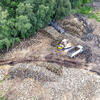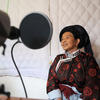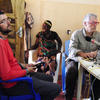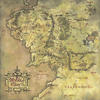You are here
The full richness of sign languages at a click

“Giovani mangia la pizza” or “Giovani la pizza mangia”: would you be able to tell which of these Italian phrases is translated from sign language and which is from spoken language? Unlike one might think, the grammatical structures of sign languages are not copied directly from their oral equivalents. In other words, deaf and hearing Italian people do not use the same grammar to express themselves – the former in sign language and the latter in spoken words. In the example cited above, the subject-verb-complement structure applies in oral Italian, but in the signed version the verb is placed at the end of the sentence.



“There isn’t just one sign language,” explains Carlo Cecchetto, a research professor at the SFL laboratory1. “For example, deaf Italian people do not use the same signs as deaf people of other nationalities.” In German and Spanish, milk is represented by the gesture of milking a cow, while the French sign is based on that of drawing milk from a mother's breast. “Each sign language is complete unto itself, with the same expressive potential and degree of lexical and grammatical complexity as a spoken language.”
A lack of linguistic tools
However, while spoken languages are not lacking in dictionaries, as well as grammar guides and studies that trace their evolution over time, identify their roots and etymologies, there are very few linguistic tools available for deaf and hearing-impaired people. A research programme initiated in 2016 by a group of European teams has resulted in the launch of the online platform Sign-Hub2.
The site is organised in three sections. One of them, comprising an “Atlas” and “Grammars”, is the first resource to offer a complete overview of the grammatical structures and characteristics of many sign languages from around the globe, as well as a detailed description of the grammar of seven sign languages: Catalan, Dutch, French, German, Italian, Castilian Spanish, and Turkish.
The aim is to enable users to enrich these grammars themselves. This information will also be useful to researchers, because sign languages offer a wealth of knowledge for studying the fundamental properties of human language.
The temporality of narratives positioned in space
“For example, concepts like phonemes and syllables were thought to be intrinsically linked to the audible facet of language,” Cecchetto explains. “However, they also apply to the visual-spatial mode. Many signs are characterised by two movements, making them disyllabic, while others are monosyllabic.”



The linguist has also shown that sign languages, like spoken ones, contain relative clauses – a characteristic that was unknown until just a few years ago! In addition, while they do not have conjugation as the concept is normally understood, their users have other ways to talk about future plans or past events: they position their narratives in space. In French sign language, the timeline is perpendicular to the body – the past is behind the back, the present is aligned with the body and the future is in front of it. However, in some sign languages used in places where people spend a great deal of time outdoors (such as the village of Kata Kolok in Bali), time can be represented on an imaginary line based on the current position of the Sun on its east-west axis.
“Moreover, the question of iconicity (the similarity between the shape of a sign and its meaning) is still being researched, in particular to find out how these visual actions comply with syntactic and grammatical rules, as well as whether and how these icons evolve over time,” Cecchetto adds.
Evaluating the language skills of the deaf
A better understanding of the structure and functioning of various sign languages will also make it possible to assess the language skills of deaf and hearing-impaired people. “Today’s health professionals have no tools for diagnosing a deaf child suffering from the equivalent of speech delay in sign language, or a hearing-impaired adult who has lost language skills due to a stroke, for example,” explains the linguist Caterina Donati3, who also contributed to the platform.
Sign-Hub now offers a test version of the first diagnostic tools for language evaluation. To develop these tools, Donati's team began by conducting a study limited to three categories of deaf people, whose community is actually highly diverse.
“In fact, most cases of deafness are not hereditary and occur at different ages,” the linguist explains. “A small proportion of deaf people are ‘native’, some of whom were exposed to sign language at a very early age. Others first tried to learn spoken language, through either oralism techniques4 or cochlear implants, and only turned to sign language after the age of three, often because oral therapy failed or the results were not satisfactory. Lastly, the third group comprises the ‘late learners’ who were not exposed to sign language until after age six. In any case, most children born deaf do not have access to sign language from birth through interaction with their parents.”
“Spectacular” learning differences
The researchers administered tests (syntactic and lexical) to people from these three categories in five different sign languages (Catalan, French, Israeli, Italian, and Castilian Spanish). The goal was to determine whether the age of earliest exposure to sign language has an impact on language skills in adulthood.
“We were expecting to find a difference, but the results exceeded our expectations,” Donati reports. “Those who had learned sign language later in life had significant difficulties in comprehension. We were able to demonstrate the importance of being exposed to sign language from the first year of life in order to truly master it later. Only lexical delay can be overcome in the case of late learning.”
These findings are crucial for parents of deaf children trying to choose between sign language and oral therapy, as well as those who teach oralism first, then resort to sign language in the case of failure. According to Donati, “We can now assert that children have no problem in learning oralism – the equivalent of a second language for people with unimpaired hearing – if they have a good command of sign language. But if they do not learn the basics of language as a baby, it becomes very difficult to teach them any other language later. Deaf or hearing-impaired children need to be exposed as early as possible to a directly accessible language, which for them means sign language.”
The platform’s third objective is to keep a record of the different sign languages and their evolution over time. “We are convinced that sign languages are part of a social and cultural heritage,” Donati emphasises, “and that they are especially at risk since they are not transmitted on a geographic scale, unlike most spoken languages.” Consequently, the site is gathering information on the history of sign language users, in the form of signed testimonies by elderly deaf or hearing-impaired people.

Several of these testimonies have been compiled in a 40-minute documentary available on Sign-Hub5. The film offers a glimpse of the experience of these men and women, some of whom lived through World War II. Some were also consigned to institutions, often religious schools, where blind and deaf students could be placed together in classes taught by teachers with no sign language skills! The subjects of the documentary talk about their professional and emotional lives, and their reactions to hearing people who seem to insist on barely moving their mouths or keeping their heads lowered when speaking, thwarting any attempt to read their lips. They also talk about how the first subtitles on television finally allowed them, sometimes at more than 50, to understand the plots of certain films, and how the advent of text messaging now makes their daily lives easier.
Ethical debate
Still, as Cecchetto explains, “Paradoxically, while France has recognised French sign language as a full-fledged language since the law of 11 February, 2005 (which grants deaf children the right to a sign language education), the ever-increasing use of cochlear implants for children is often not accompanied by exposure to a sign language. This poses a risk in the event that the implants do not work well enough to enable good oral language acquisition, which is always a possibility.”
Indeed, although they are often very effective and can change the lives of some deaf people, implants are not technically suitable for everyone. More importantly, they are still the subject of ethical debate, as part of the deaf community considers them a threat to their culture.
In France, approximately one in 1,000 children is born profoundly deaf, and three of every 1,000 children have severe or profound deafness by the age of three. There are about 100,000 deaf signers, of whom only 5% have a deaf family member who would be able to teach them sign language. As Donati and Cecchetto point out, this large group of people, already disadvantaged due to their disability, have a real need for a platform like Sign-Hub, a place for contact and discussion, for sharing experiences and knowledge. ♦
For further reading
How speech comes to children
Muting tinnitus
- 1. SFL, unité CNRS/Université Vincennes-Saint-Denis.
- 2. https://thesignhub.eu/fr
- 3. Professor at the LLF laboratory of formal linguistics (CNRS / Université Paris Cité) and director of the Linguistics education and research unit at Université Paris Cité.
- 4. Oralism is a method of teaching spoken language to deaf people based on two principles: first, the use of hearing aids and cochlear implants, which can give them a degree of useful everyday hearing ability; and secondly, teaching them to use vision to improve their ability to decode speech sounds by watching the speaker’s lips. The relative merits of oralism vs. sign language are the subject of ongoing debate.
- 5. The documentary “We were there… We are here”, produced by a team from Bosphorus University in Istanbul (Turkey), can be viewed at https://thesignhub.eu/life-story/36














